March 8th 2004
It's been a busy week again, because I've been trying to get a lot of freelancing cleared, and then I went to visit Kyuushuu at the weekend. We're also moving more quickly in school, as I think I mentioned last week. Last week in school was fairly normal, as far as I remember. I had dinner with Mary on Thursday, one of Amy's housemates, from Singapore, so that was nice, but other than that my life was mainly composed of work.
I got back from Kyushu quite late last night, to discover that the server for sending mail was playing up again. It seems to be OK again now, so people may get email soon; or, at least, as soon as I have time. We have a big test tomorrow, but I'm not going to do any study for it. But I don't have to. You see, I've been to the most powerful scholarship shrine in Japan.
Which brings us on to Kyushu.
The Japanese archipelago has four main islands. Honshu is the biggest, and the one with Tokyo, Kyoto, and Okazaki. It's the only one my visitors will see, I think. Kyushu is, I think, the next largest in terms of population, and it is off the south western end of Honshu. It is the closest island to Asia, and has thus been the conduit for external influence on Japan for most of its history. I went to Fukuoka, which is the city closest to Honshu, and thus has been the point of contact between the two islands for centuries. It's now where the Tokaido shinkansen from Tokyo terminates.
Fukuoka and Hakata
I left for Kyuushuu after school on Friday, getting the 3:30 shinkansen from Nagoya. I've been steadily getting earlier shinkansen as my time here has progressed, but I think that's the earliest I can manage. I don't want to carry all my weekend luggage to school, or all my school books on trips, so I need to go home between school and catching the train in Okazaki. Still, the shinkansen to Fukuoka only takes three and a half hours, which is really fast, so I was in Kyuushuu quite early. The hotel was very close to the station, which was good, because the weather was truly dreadful: high winds, pouring rain, and lightning. I ended up getting the underground 500m, which cost 200 yen. I found out the following day that there is an underground footway covering the same distance, so on later days with bad weather, I walked.
The hotel room was nice, but not perfect. The hotel has eleven storeys, and the 'corridor' with the rooms off it is open air, along one side of the hotel. There is netting and plastic sheeting, obviously designed to fix the tendency of rain to blow in. I was on the eleventh floor, right under the sheeting. In the violent winds Friday night, it was loud, as was the sign behind the fire extinguisher. So I didn't sleep as well as I might have done, but I still managed quite well. I suspect that it would be no problem if you were on the ninth floor or below, as it wouldn't be so close.
Also on Friday night, one of the lightning flashes caused a brief power outage while I was in the lift, making it jerk to a stop. I was glad that I spoke Japanese, and thus knew that the message was 'please wait a short while', not 'wait for someone to come and rescue you'. Anyway, it soon moved back down to the nearest floor, and I decided to walk the rest of the way up to my room, under the circumstances.
On Saturday I met up with Yuko Kagami, one of my friends from Cambridge, at Hakata station, the shinkansen terminus. Hakata is one of the old districts of Fukuoka, and, it seems, one of the most culturally influential. Our plan was to see Fukuoka on the Saturday, and go to Dazaifu on Sunday, but the weather was dreadful. It had, at least, stopped raining, but it was very cold with a really strong wind. At various points during the day, it was hard to walk into the wind, although it never quite got to be impossible.
The first place we went was 'Seaside Momochi' (shiisaido momochi). This is an area of reclaimed land, with modern skyscrapers, housing, and Fukuoka Tower on it. It is also the home of the Daiei Hawks, Fukuoka's baseball team, who have a stadium in a large dome with an opening roof. The roof is normally kept closed, but does open about fifteen minutes before the end of the game if it looks like the Hawks are going to win, so that they can launch fireworks afterwards. When we arrived, vast hordes of people were arriving for a game agains the Yomiuri Giants, and the Japanese ticket touts were out in force.
Around the stadium is an area called 'Hawks Town', containing a number of shops, and a large number of bronze casts of famous people's hands. We have a photo of me 'shaking hands with Frank Sinatra'. They did look a little peculiar, sticking out from simple metal supports all the way along the walkway around the dome.
Next to the dome is a hotel called Sea Hawk. Both buildings are right on the coast, so I presume the hotel took its name from the sea and the Hawks. Someone then decided that it sounded like a pirate ship. The guy on the door was dressed in what is hands-down the most stupid looking job uniform I have ever seen. Yuko told me not to laugh as we were approaching the door, and I tried not to stare as well. It had a large over-cloak, one of those curvy admiral's hats, and what looked a bit like an eighteenth century naval uniform underneath.
We went into the hotel because, in the main lobby on the third floor, they have a tropical garden, which was a nice break from the cold weather outside.
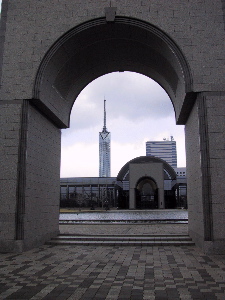 Fukuoka City Museum (in front) and Fukuoka Tower (behind, to the left).
Fukuoka City Museum (in front) and Fukuoka Tower (behind, to the left).
From there, we walked to Fukuoka Tower. This looks a bit like an office building, but actually it's a glass-clad Eiffel Tower equivalent. It's 234 metres tall, with viewing floors 123 metres up. Yuko hadn't been up before, so we went up to have a look at the view. It was quite spectacular, with mountains beyond the city to one side, and the sea to the other. The mountains occasionally disappeared in the blizzards that blew past, and we decided to have lunch in the cafe 120 metres from the ground when we noticed the snow rushing horizontally past the windows. The food in the cafe was a bit pricey, but surprisingly good for a tourist trap.
After Fukuoka Tower, we went to the Fukuoka City Museum. This is also on the reclaimed land, and it's a very impressive building. The exhibit on the history of the town was superb, and included the museum's greatest treasure, the Kin'in, or gold seal. This was a gift from the Chinese emperor to the king of Na in the first century AD, and it was found in the eighteenth century on one of the islands in Hakata bay. It was identified because the Chinese chronicles record the despatch of the gift. It's quite small, but really rather beautiful.
The rest of that room was equally impressive. Fukuoka was the site of the government of Kyushu for most of its history, at least from the Heian period onwards, and it was also where the mongols tried to land when they tried to invade Japan. Their first attempt was beaten back by the Japanese defenders, their second, larger, force by a convenient typhoon, the kamikaze, or divine wind. One of the really stand-out things about this room was the quality of the English translations. Until the near the end, I though they'd been done by a native speaker, but then there were a couple of idiomatic errors suggesting that they were actually done by a very, very good Japanese person.
The rest of the museum's contents were less impressive. It felt rather like a superb building that was still waiting for things to display that were worthy of the surroundings. No doubt it will get there eventually.
Our next stops were the major shopping centres in Fukuoka. Kawabata is a covered road with shops on each side -- a true shopping arcade. There were a lot of shops selling little shrines to put in your house, and you could almost buy a house for the price of some of the larger ones. (OK, not a house in Japan, but still...)
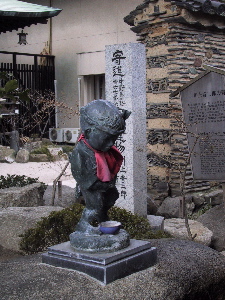 An interesting fountain in Kushida Shrine.
An interesting fountain in Kushida Shrine.
At the end of that road was the Kushida shrine, one of the most important Shinto shrines in Fukuoka itself. The shrine is the starting point for a big summer festival, in which groups of men carry a positively huge float through the city. The float was still on display. It must have been at least thirty feet tall. At this thing is carried; it doesn't have wheels. Kushida shrine also had a statue that reminded me of Europe...
There was a wedding happening in the shrine while we were there, so we tried to stay out of their way while having a look around. Given the structure of Japanese shrines, this is rather easier to do than it would be in an English church.
From Kushida, we went to Canal City, which is another large shopping complex, built around a canal. At the moment, the canal is being refurbished, so it's full of coloured balloons rather than water. And then it was on to the Hachiya Machi Folk Museum, next door but one to my hotel, to see some reconstructions of the past of Hakata, before having high-class kaiten sushi for dinner. (Kaiten sushi is the conveyor belt sushi -- kaiten means 'goes around'.)
Afterwards, we hunted down a shop selling compact flash cards, because I didn't have enough space left on my camera for Dazaifu photos, so I had to buy a new card. I bought a 128MB one, which can hold about 100 pictures, and which was adequate for the following day.
Dazaifu Tenmangu
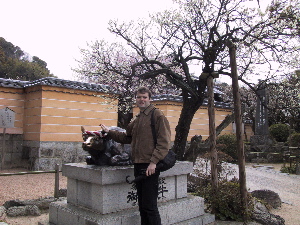 Me touching the bronze cow outside the main shrine. Everyone does this 'for luck', which means no-one can remember the original reason.
Me touching the bronze cow outside the main shrine. Everyone does this 'for luck', which means no-one can remember the original reason.
On Sunday, we went to Dazaifu Tenmangu, one of the most important Shinto shrines in Japan. In the late ninth and early tenth centuries, a scholar called Sugawara Michizane was very important in the Imperial court at Kyoto, rising to one of the highest positions of state. However, he was not a member of the influential Fujiwara family, and through political machinations he was appointed governor of Kyushu, a post which constituted effective exile. He was unhappy about leaving, as, apparently, was one of the trees in his garden, which flew to Kyushu to be with him. You can still see the tree in the grounds of the shrine.
Assuming I'm remembering correctly, Michizane died in Kyushu, and the Imperial family was promptly visited with a series of misfortunes. They decided that this was because he was annoyed with them, and placated his spirit by posthumously promoting him to a very high rank, and declaring that he was a god. This seemed to work, and his shrine in Kyushu became very popular. Because he was a renowned scholar, it became particularly associated with scholarship, and Japanese people often go there to pray for success in examinations. The importance of exams in Japanese life probably helps to ensure the continued popularity of the shrine.
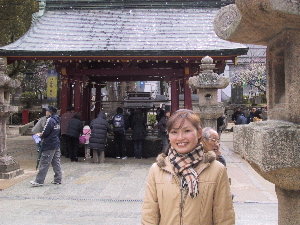 Yuko at Dazaifu Tenmagu. The snow on the picture is actual snow, not a problem with the camera.
Yuko at Dazaifu Tenmagu. The snow on the picture is actual snow, not a problem with the camera.
We were hoping to see a special ceremony, which happens once a year, in which people dressed in Heian costume write waka (traditional Japanese poems that predate haiku by about a thousand years) while little boats float down a stream towards them. However, the information noted that it was postponed in case of rain, and we suspected that the driving blizzard might also postpone it.
Dazaifu is some distance outside Fukuoka, and the train leaves from the first floor of the Mitsukoshi department store. We got the express, so it only took half an hour in total, including waiting for the local train to take us the last couple of stops. When we arrived, it was still snowing, but there were a lot of people there.
The walk from the station to the shrine passes under three concrete torii, and between a multitude of shops selling souvenirs of various kinds, including one shop devoted to Hello Kitty.
The shrine is beautiful. It has a wonderful setting, with forested hills rising up all around it, and it was thronged with people in all the main areas. There is a three-fold bridge leading to the shrine, with two high arches and a flat section in between. Apparently, these represent the past, present, and future, so in the present you cannot see all of the past, nor very far into the future.
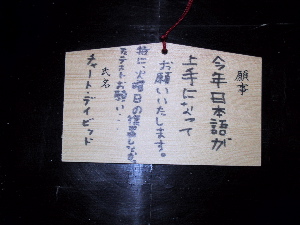 My negai-ema. The handwriting is particularly bad, because my hands were cold. The column at the far left is my name in Japanese characters.
My negai-ema. The handwriting is particularly bad, because my hands were cold. The column at the far left is my name in Japanese characters.
The shrine itself is decorated in red and gold, and the main buildings form a single courtyard, which contains the aforementioned flying tree, a couple of pools, and the main building where Michizane is formally enshrined. The wings of the courtyard are basically shops selling o-mamori, predominantly scholarship charms. I bought one, of course, to add to my collection, but I also bought a negai-ema. These are, basically, votive plaques, on which you write a request for the kami-sama. I asked to be made good at Japanese, and for help with tomorrow's test. So If I do well tomorrow, I should probably go back and write a thank-you note...
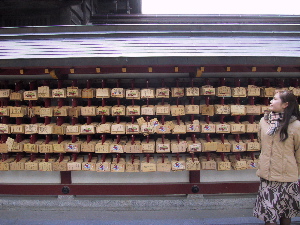 My plaque hung up (centre top), among many others.
My plaque hung up (centre top), among many others.
You then hang the plaque on one of the pegs at various points around the shrine. There are a lot of these, all full. One measure of the shrine's popularity is that there is no entrance fee. Obviously, it makes enough money from the sale of o-mamori and negai-ema to cover its running expenses. It may also have a state subsidy of some sort, but I'm not sure it needs one.
One of the remarkable things was the transformation when you left the main courtyard. On the slopes around it, in among the ancient trees, were a large number of other shrines, and these areas were all but deserted. Certainly, we had the place to ourselves while we were looking around, although there was someone else up there when we went past again later. This seems to happen quite a lot at most Japanese temples; you don't need to go very far at all from the beaten track to find peace and quiet.
By this time, although it was still cold, it had stopped snowing, so we decided to see if the ceremony was happening. It looked like it was, so we took our seats, an hour and more before it started. The seats were more than half full at that point, at least the free ones for ordinary people. Fortunately, the view was nice. The garden where the ceremony takes place is a plum orchard, and the plums were in bloom. It snowed periodically, and according to Japanese convention I should say that I couldn't tell the difference between the snow and the blossoms, but actually it was easy. The snow was rushing through the air on the biting wind, while the blossoms were stuck to the trees. Plus, some of the blossoms were pink.
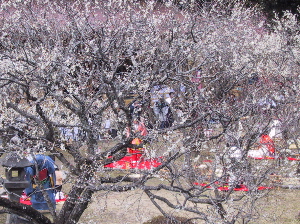 The Kyokusuien ceremony through the plum blossoms.
The Kyokusuien ceremony through the plum blossoms.
Eventually, the ceremony started, and I use the word 'ceremony' advisedly. It was very, very slow, and our view was somewhat obstructed by the blossoms. Now, watching an evocation of the Heian era through a veil of plum blossoms is terribly appropriate and evocative, but that doesn't make it any easier to see. That is why the photograph didn't come out terribly well.
On the other hand, I'm very glad I saw it. It was fascinating, and I even understood a fair bit of the commentary. It all started with ritual purification of the site by one of the shrine's priests, and that was followed by traditional court dances. The first was performed by a man, in full Heian costume. This involved trousers about twice as long as his legs, which trailed on the ground. He managed the whole dance without falling over or getting them fouled, which must have taken a lot of practice, even though he wasn't moving very fast.
The next dance was performed by four of the shrine maidens, or miko, accompanied by several more on various traditional instruments, and singing. Again, it was very slow, but extremely interesting.
Then people got set up for the event itself. There were two ceremonial guards, dressed in blue and carrying bows and arrows, the standard arms in the Heian period (the swords came later). Then there were equal numbers of men and women, dressed in large robes. Each woman had an attendant in a black kimono to keep an eye on her train and robes, and make sure they didn't get fouled up. The poets sat along the stream, I think with men facing the women across the water, but I'm not sure. Each had a young boy, dressed in a white Heian costume, as an attendant.
Then, I get a bit vague on what was happening. I think the boys were supposed to fish the floating thing out of the river when it reached their person, and the person was supposed to have finished writing their waka by that point. Certainly, waka were written and read out, but they are conventionally written in rather archaic Japanese, so I didn't understand them. We left a bit before the end, because it was getting very cold sitting there, and that also provided a chance for some of the people in the queue to get in and see it before it all finished.
We had a late lunch in one of the restaurants on the souvenir street, and it was good and reasonable, which was a bit surprising. I ate a traditional sweet, which consisted of rice cake around anko (sweet bean) paste, like virtually every other traditional sweet in Japan. These are round, and stamped with a representation of a plum blossom. (Actually, to be fair, the traditional sweet at Ise was anko paste around rice cake. There is variety.)
After we got back to Fukuoka we had an hour to kill, so we wandered around the underground shopping centres and such for a bit, and looked at some very expensive sushi on the top floor of Mitsukoshi. Then I got back on the shinkansen and headed home, arriving back about ten o'clock.
It was a very busy weekend, but it was a lot of fun, and I liked Kyushu a lot. The scenery was beautiful, and Fukuoka appeared to be a nice city -- large enough to have everything, but not a vast, sprawling megalopolis like Tokyo. The weather might not have been at its best, but it was still an excellent trip. Now I need to take a break to prepare for the invasion of the barbarian hordeseagerly awaited family visit.